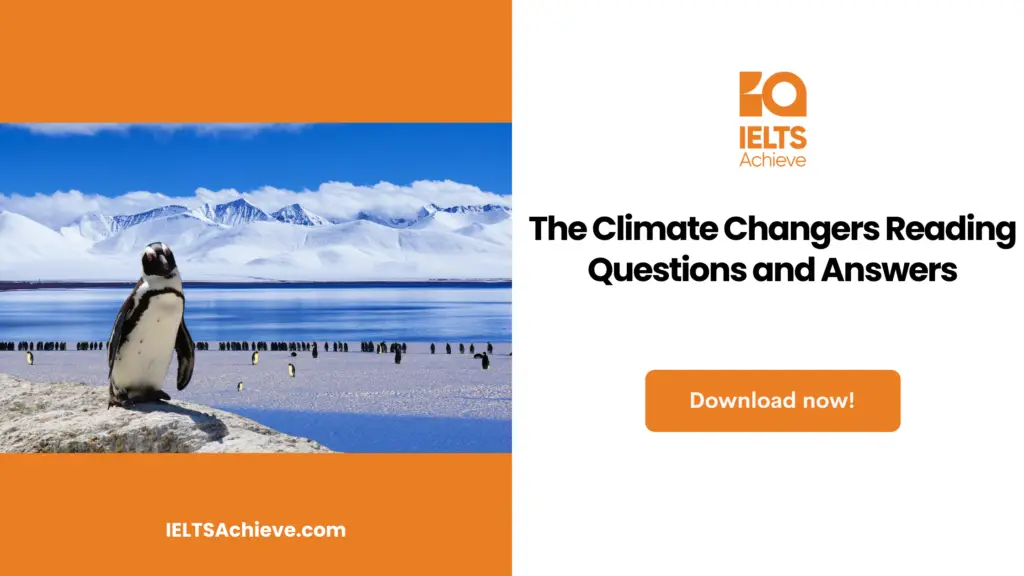The Blog post contains the following IELTS Reading Questions:
- IELTS reading multiple choice questions
- IELTS reading summary completion
- IELTS reading true false not given
Stay informed and prepared for success – Explore our comprehensive Reading Test Info page to get valuable insights, exam format details, and expert tips for mastering the IELTS Reading section.
IELTS Reading Passage – The Climate Changers

The Climate Changers
The idyllic idea that prehistoric humans were able to coexist peacefully with their natural surroundings has been heavily criticized in recent years. Modern humans may have begun eradicating other species from the very beginning; our ancestors have been blamed for eradicating megafauna, including giant flightless birds in Australia, mammoths in Asia, and ground sloths in North America, as they spread across the globe. In spite of this, there were only about 12 million people in the world by about 6,000 years ago, which is less than a quarter of the current population of Great Britain. That’s a lot fewer people than the 6.6 billion who currently inhabit the Earth, most of whom consume fossil fuels, produce greenhouse gases, and generally mess with the planet’s climate as if there is no tomorrow. That humans have been the primary cause of global warming ever since our forefathers began clearing forests to plant crops at least 7,000 years ago may seem implausible to some.
But that’s the opinion of William Ruddiman, a climate scientist who retired from the University of Virginia in Charlottesville. He claims that climate-warming carbon dioxide and methane were being released into the atmosphere by ancient farmers well before written history was even invented. However, early farmers actually prevented Earth from entering another ice age and kept temperatures stable for thousands of years. It’s hard to believe that a few stone-age farmers could have altered global weather patterns. You are not alone if you find this hard to believe. Since Ruddiman first suggested it in 2003, his idea has generated intense debate. The majority of novel ideas, especially divisive ones, are quickly forgotten. He claims that scientists can quickly eliminate such individuals using scientific methods. Even now, five years later, nobody has abandoned his concept. Instead, he claims that recent developments only serve to bolster his position. Natural explanations for the increase in greenhouse gases over the past few thousand years are the ones that are not measuring up, he claims, so we can reject them.
There can be no doubt that human activities are responsible for the skyrocketing levels of carbon dioxide and other greenhouse gases that we see in the atmosphere today, which have contributed to a 0.7° C increase in average global temperature during the 20th century. Ruddiman, however, began to have doubts in the late 1990s that humankind’s contribution to the global greenhouse had not become significant until well after the advent of industrialization. Atmospheric C02 and methane levels have fluctuated over the past 400,000 years, as discovered by an ice core drilled at the Vostok station in Antarctica. The ancient atmosphere during the last three interglacials can be pieced together from bubbles preserved in the ice.
We observe a periodic pattern of increases and decreases that coincides with the arrival and departure of ice ages and has a period of about 100,000 years. These reoccurring patterns can be explained by the fact that the amount of sunlight striking Earth is subject to change due to regular shifts in the Earth’s orbit and axis of rotation. This is one of the brief, warm interglacial periods that occur after an ice age. Within this overall trend, methane levels tend to peak at regular intervals of about 22,000 years, coinciding with the times when the Earth’s orbit causes the northern hemisphere to experience its warmest summers. Because warm northern summers cause strong tropical monsoons in southern Asia, which both promote the growth of vegetation and cause flooding, which results in vegetation rotting in oxygen-poor water, emitting methane. When summers are particularly warm in the Arctic, permafrost melts for longer periods of time, allowing plants to grow and methane emissions to occur once more.
Recent years have seen a deviation from this previously observed pattern. Around 11,000 years ago, methane levels peaked at about 700 parts per billion (ppb), before declining. Atmospheric methane levels had been declining, but they reversed course around 5,000 years ago and have been rising ever since, despite Ruddiman’s estimates that they should be no more than 450 parts per billion today. Ruddiman, in collaboration with climate modelers Stephen Serves and John Kutzbach, has demonstrated that vast areas of northern Canada and Siberia would currently be covered by ice sheets if levels of these gases had continued to fall rather than rise when they did. Another ice age would be upon the world. Why, then, have atmospheric concentrations of both methane and carbon dioxide increased over the past few hundred and thousand years? What makes this interglacial period unique in comparison to others? What if we’re to blame?
Some 11,000 years ago, agriculture first appeared in the eastern Mediterranean, then in China, and finally in the Americas. Clearing forests releases large amounts of stored carbon as the wood decays or is burned, and flooded rice paddies release methane in the same way that wetlands do. Ruddiman started looking into agricultural history books and articles to learn more about the origins of farming. Based on these findings, we know that rice cultivation in Asia experienced a dramatic upswing sometime around the year 5000 BCE, with the trend quickly spreading across China and Southeast Asia. At least this explained where the sudden increase in methane levels could have come from.
Unlock your full potential in the IELTS Reading section – Visit our IELTS Reading Practice Question Answer page now!
Recommended Questions:
Renewable Energy IELTS Reading Question with Answer
The Climate Changers Reading Questions
Questions 1-3
Choose the correct letter, a, b, c, or d
1. The title’s climate-altering offenders are
- Farming in its earliest stages
- All-Natural causes
- Today’s humans
- Weather forecasters
2. To what extent is this the first time this information has been made public thanks to the studies conducted at Vostok?
- that there was a rise in methane levels around the year 5,000
- we are currently in a warm interglacial
- that methane levels leveled off around the year 11,000
- methane bubbles exist in Antarctica’s ice
3. Ruddiman claims, for instance,
- His viewpoints aren’t even remotely divisive
- Climate change predictions made by scientists have been wrong so far.
- World temperatures are rising because of a rise in the human population.
- Humans have been changing the weather for eons.
Ready to improve your performance in Multiple Choice Questions (MCQs)? Click here to access our comprehensive guide on how to tackle MCQs effectively in the IELTS Reading section.
Questions 4-8
Complete the summary.
Choose NO MORE THAN TWO WORDS from the passage for each answer.
| Many people believe the controversial theory that 4.___________ are to blame for global warming appears 5.____________. Carbon dioxide and methane are both 6._____________, or greenhouse, gases, and Ruddiman thinks that significant amounts of both were being released into the Earth’s atmosphere in times prior to 7._____________. But according to Ruddiman, this actually had a beneficial effect, as it may have prevented another 8.____________. |
Boost your performance in Summary, Notes, Table, and Flowchart Completion tasks. Click here to explore our detailed guide and learn how to effectively complete summaries, notes, tables, and flowcharts in the IELTS Reading section.
Questions 9-14
Do the following statements agree with the information given in Reading Passage? In boxes 9-14 on your answer sheet write
TRUE if the statement agrees with the information
FALSE if the statement contradicts the information
NOT GIVEN if there is no information on this
9. The 20th century saw the greatest increase in global temperatures in recorded history.
10. There is now undeniable evidence in the scientific community that confirms Ruddiman’s theory.
11. Temperatures around the world can be influenced by small shifts in the Earth’s orbit.
12. Today, agriculture is blamed as one of the main contributors to climate change.
13. In the last 100 years, humans have wiped out some species of megafauna.
14. In the scientific community, there was a lot of back and forth about Ruddiman’s theory.
Enhance your skills in identifying information as True, False, or Not Given. Click here to discover expert strategies and techniques for mastering this question type in the IELTS Reading section.
Unlock your full potential in the IELTS Reading section – Visit our IELTS Reading Practice Question Answer page now!
Recommended Questions:
Renewable Energy IELTS Reading Question with Answer
The Climate Changers reading answers
1. a
2. a
3. d
4. ancestors
5. implausible
6. climate-warming
7. written history
8. Ice age
9. Not given
10. False
11. True
12. Not given
13. False
14. True

We hope you found this post useful in helping you to study for the IELTS Test. If you have any questions please let us know in the comments below or on the Facebook page.
The best way to keep up to date with posts like this is to like us on Facebook, then follow us on Instagram and Pinterest. If you need help preparing for the IELTS Test, join the IELTS Achieve Academy and see how we can assist you to achieve your desired band score. We offer an essay correction service, mock exams and online courses.
